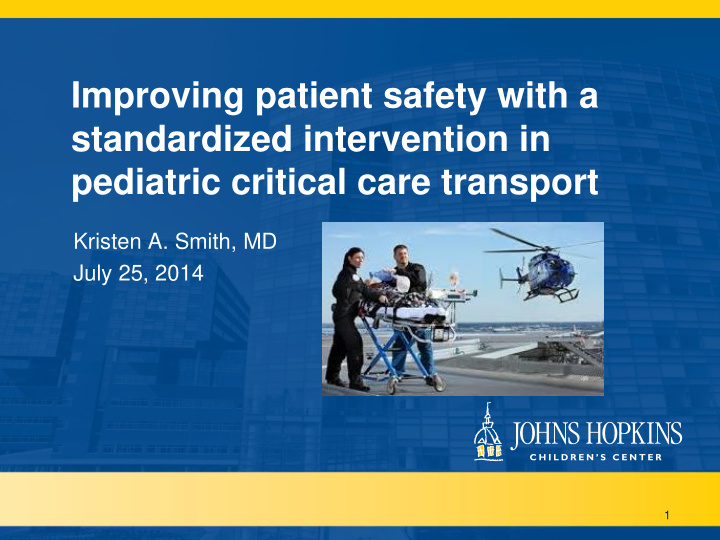



Improving patient safety with a standardized intervention in pediatric critical care transport Kristen A. Smith, MD July 25, 2014 1
Background • Communication failure is leading cause of adverse events: – Medication errors – Delays in diagnosis – Delays in definitive care – Repeats in diagnostic testing – Omissions of care 2
Background • Last year in Johns Hopkins Children’s Center: – > 65 reported medication errors – > 100 reported duplications in diagnostic work-up – > 150 reported delays in patient care due to inadequate medical record from referral hospital 3
Background • Transitions in care are prime examples when communication breakdown can lead to patient harm 4
Background Patient presents to community hospital for care 2,500/ Care of patient transferred to transport personnel to bring child to year Johns Hopkins Children’s Center Patient admitted to Pediatric 300/ Intensive Care Unit (PICU) year 5 Patient hand-off point
Background • Transport Team – Nurses – Paramedics – Respiratory Therapists – Physicians NO FORMALIZED WAY TO EXCHANGE PATIENT INFORMATION! 6
Hypothesis • Adverse events will be reduced after implementation of a standardized intervention for patients transported directly to the pediatric intensive care unit (PICU) from outside hospitals by the pediatric transport service. 7
Timeline Oct Mar Mar Aug Oct 2013 2014 2015 2014 2014 Pre-implementation Post-implementation Data Data Education Implementation & Training 8
Intervention • Didactic lecture • Simulation experience • Patient hand-off script 9
Transport Hand-off Script • Transport RN/MD • Patient demographics: Name, age, weight, allergies • CC/HPI: Brief summary • OSH Work-up/therapies: Labs (completed & pending), diagnostic and 1 radiographic testing, medications, treatments • Transport team therapies: Assessment, meds, response the therapies • * Pause for questions/clarification • Transport RT (if applicable) • Assessment • Interventions and responses to treatments • Intubation (if applicable): ETT size, depth 2 • Any additional information required for patient care • * Pause for questions/clarification • Accepting Provider (MD/NP) • Summarize working diagnosis • Review of Plan: • Neuro: pain issues, neuro checks, seizure plan, sedation plan • Cardio/Resp: Monitoring, frequency of treatment(s), resp support needs (NC, BiPap/CPAP, etc) 3 • FEN/GI: Diet, fluids • ID: Antibiotic plan • Gen Care: Labs, access, foley 10 • *Pause for questions/clarification
Outcomes • Primary – Medication errors • Secondary – Delays in diagnosis or definitive care • i.e. surgery – Repeats in diagnostic testing – Omissions of care • All adverse events must occur within 48 hours of transfer 11
Outcomes • Ascertainment – Patient Safety Network (PSN) • Online, anonymous adverse event reporting system • Used by nurses, physicians, pharmacy staff, respiratory therapy for over 10 years at Johns Hopkins – Data will be retrospectively analyzed from existing database 12
13
Study Population • Inclusion criteria • Exclusion criteria – Age birth-22 years – Patients transported by another medical – Transported directly vendor to PICU by Johns – Patients triaged Hopkins pediatric transport service through emergency • >300 annually department (ED) prior to PICU admission 14
Statistical Analysis • Chi-square comparison of number of adverse events per transfer pre- implementation and post-implementation – Medication errors – Delays in diagnosis or definitive care – Repeats in diagnostic testing – Omissions of care 7/30/2014 15
Limitations • Retrospective review • Historical data used for control • Single-center study • Adverse event reporting system does not catch all events • No existing data proving link between adverse events and communication issues 16
Significance • Reducing adverse events during transport could save lives • Johns Hopkins Children’s Center’s Pediatric Transport Team transports over 2,500 patients each year to our facility – Each transport involves multiple exchanges of information that could be vital to that patient’s care • After project completion, the hope is to use these tools throughout the children’s center to improve patient hand-off 17
Acknowledgements • Dr. Lawrence Appel - instructor • Dr. Kuni Matsushita - instructor • Dr. Mariana Lazo-Elizondo - instructor • Dr. Maria Brinez Giraldo • Dr. Anda Gonciulea • Dr. Sahar Koubar • Dr. Heather Weinreich 18
QUESTIONS? 19
Recommend
More recommend